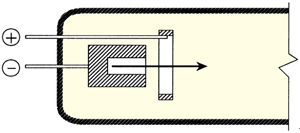5. Structure and Principle of Emission of the HCL
Q: "What about the inside (structure) of the HCL? How does it emit light?"
A: Let's begin with the inside (structure)... It is a discharge tube consisting of a hollow cylindrical cathode and an anode, enclosing a small amount of noble gases such as neon.

Principle of emission
Voltage is applied between the electrodes to cause discharge.
→The filler gas is ionized.
→Ions collide with the cathode.
→The vapor of cathode material is jetted (the vapor is in the ground state).
→The atoms, electrons, ions, etc in the filler gas collide with the vapor to bring it to an excited state.
→The atomic vapor in the excited state emits light to return to the ground state.
The wavelength of the emitted light depends on the cathode material.
If the cathode is made of copper, an emission line with a wavelength peculiar to copper will be emitted.Since the cathode is hollow, ions enter the hollow intensely, leading to efficient (high luminance) emission.
In an atomic absorption photometer, an HCL which emits a wavelength with which atomic absorption by the metallic element to be measured is possible is selected.
For example, an HCL dedicated to copper is used to measure copper.(One element - one lamp)
